ESP Citroen C4 PICASSO 2016 2.G Service Manual
[x] Cancel search | Manufacturer: CITROEN, Model Year: 2016, Model line: C4 PICASSO, Model: Citroen C4 PICASSO 2016 2.GPages: 527, PDF Size: 13.72 MB
Page 172 of 527
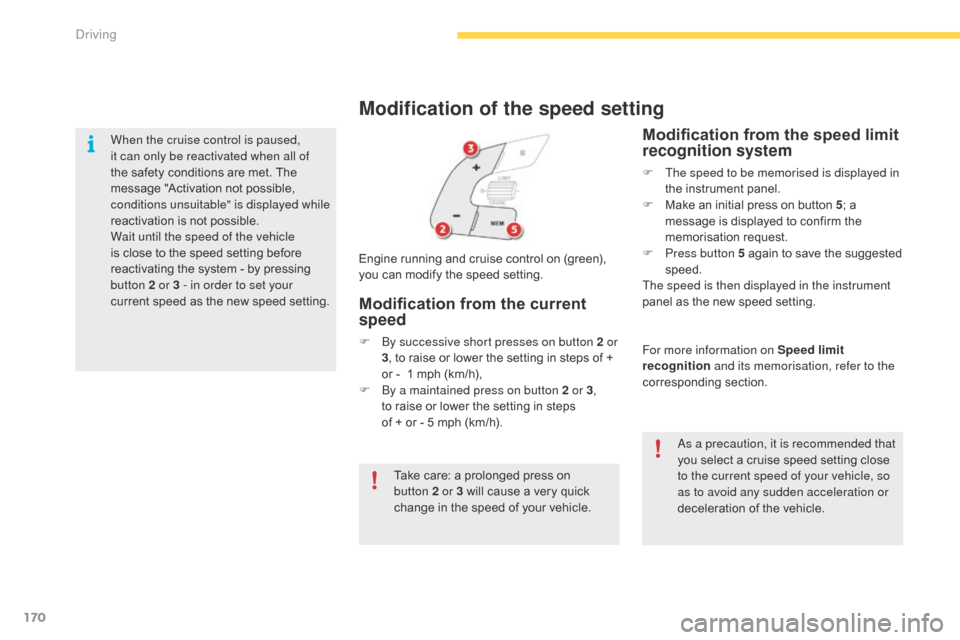
170
C4-Picasso-II_en_Chap04_conduite_ed01-2016
When the cruise control is paused,
it can only be reactivated when all of
the safety  conditions  are  met.  The Â
m
essage  "Activation  not  possible, Â
c
onditions unsuitable" is displayed while
reactivation
 is  not  possible.
Wait until the speed of the vehicle
is
 close  to  the  speed  setting  before Â
r
eactivating  the  system  -  by  pressing Â
b
utton 2 or 3 - in order to set your
current
 speed  as  the  new  speed  setting.
Modification of the speed setting
Modification from the speed limit
recognition system
F The speed to be memorised is displayed in the  instrument  panel.
F
Â
M
ake  an  initial  press  on  button  5;
 a Â
m
essage  is  displayed  to  confirm  the Â
m
emorisation
 r
equest.
F
P
ress button 5  again  to  save  the  suggested Â
s
peed.
The speed is then displayed in the instrument
panel
 as  the  new  speed  setting.
As a precaution, it is recommended that
you
 select  a  cruise  speed  setting  close Â
t
o the current speed of your vehicle, so
as to avoid any sudden acceleration or
deceleration
 of  the  vehicle.
For more information on Speed limit
recognition
and its memorisation, refer to the
corresponding
 s
ection.
Engine
Â
running
Â
and
Â
cruise
Â
control
Â
on
Â
(green),
Â
y
ou
Â
can
Â
modify
Â
the
Â
speed
Â
setting.
Modification from the current
speed
F By successive short presses on button 2 or 3,
 to  raise  or  lower  the  setting  in  steps  of  + Â
o
r  -   1  mph  (km/h),
F
B
y a maintained press on button 2 or 3 ,
to
 raise  or  lower  the  setting  in  steps Â
of
 +  or  -  5  mph  (km/h).
Take
 care:  a  prolonged  press  on Â
b
utton 2 or 3  will  cause  a  very  quick Â
c
hange  in  the  speed  of  your  vehicle.
Driving
Page 178 of 527
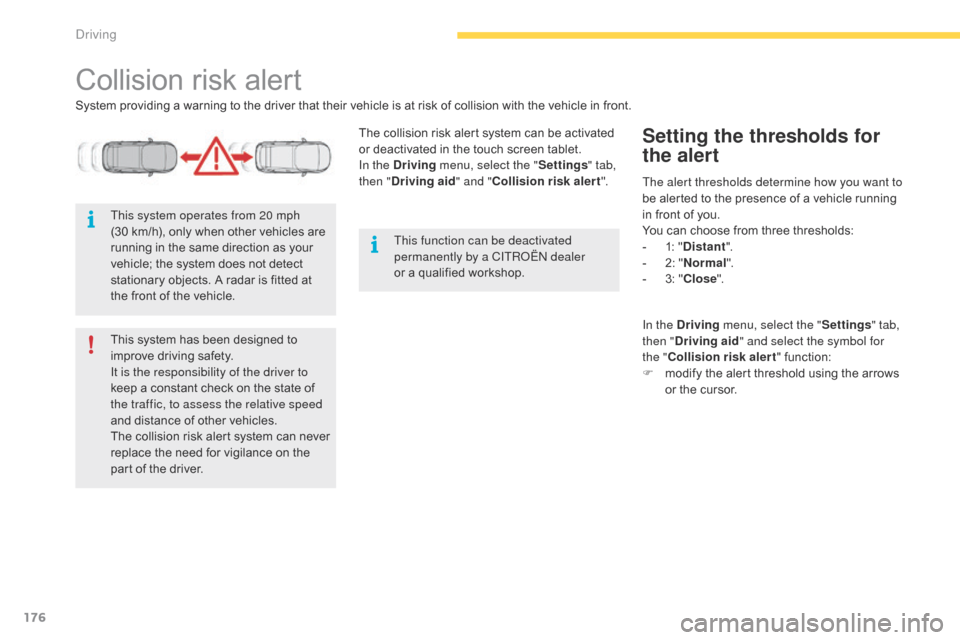
176
C4-Picasso-II_en_Chap04_conduite_ed01-2016
Collision risk alert
System providing a warning to the driver that their vehicle is at risk of collision with the vehicle in front.
T he  collision  risk  alert  system  can  be  activated Â
o
r  deactivated  in  the  touch  screen  tablet.
In the Driving menu, select the " Settings" tab,
then " Driving aid " and "Collision risk alert ".
This
 system  has  been  designed  to Â
i
mprove  driving  safety.
It is the responsibility of the driver to
keep
 a  constant  check  on  the  state  of Â
t
he traffic, to assess the relative speed
and
 distance  of  other  vehicles.
The
 collision  risk  alert  system  can  never Â
r
eplace  the  need  for  vigilance  on  the Â
p
art  of  the  driver.
This system operates from 20 mph
(30Â km/h),
 only  when  other  vehicles  are Â
r
unning  in  the  same  direction  as  your Â
v
ehicle;  the  system  does  not  detect Â
s
tationary  objects.  A  radar  is  fitted  at Â
t
he  front  of  the  vehicle. The alert thresholds determine how you want to
be
 alerted  to  the  presence  of  a  vehicle  running Â
i
n  front  of  you.
You
 can  choose  from  three  thresholds:
-
Â
1
: Â "Distant ".
-
Â
2
: Â "Normal ".
-
Â
3
: Â "Close ".
Setting the thresholds for
the alert
This function can be deactivated
permanently by a CITROĂ‹N dealer
or
 a  qualified  workshop.
In the Driving menu, select the " Settings" tab,
then " Driving aid " and select the symbol for
the " Collision risk alert "
 function:
F
Â
m
odify  the  alert  threshold  using  the  arrows Â
o
r  the  cursor.
Driving
Page 180 of 527
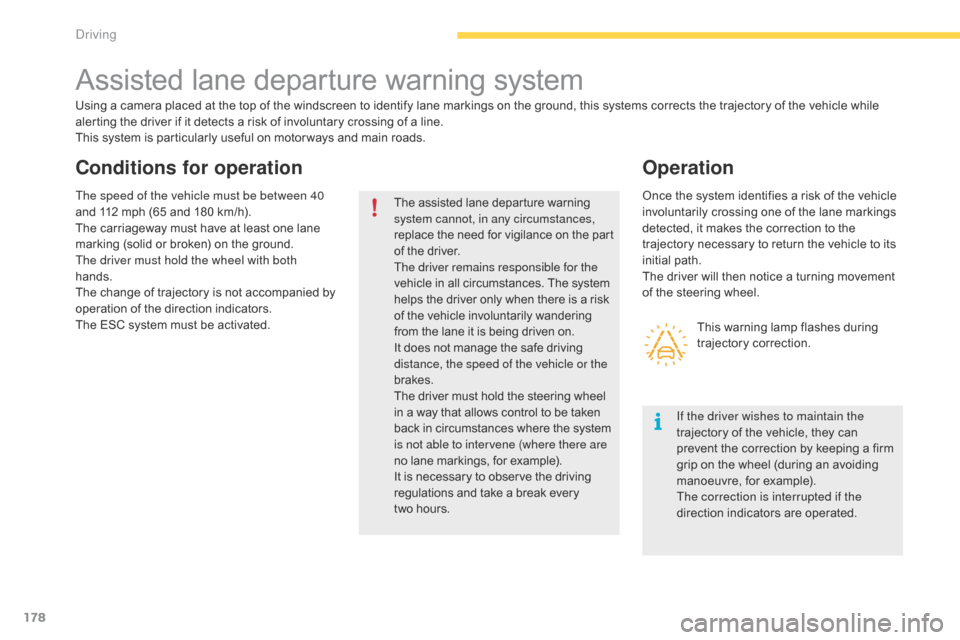
178
C4-Picasso-II_en_Chap04_conduite_ed01-2016
Assisted lane departure warning system
Using a camera placed at the top of the windscreen to identify lane markings on the ground, this systems corrects the trajectory of the vehicle while alerting  the  driver  if  it  detects  a  risk  of  involuntary  crossing  of  a  line.
This
 system  is  particularly  useful  on  motor ways  and  main  roads.
The
 assisted  lane  departure  warning
 s
ystem cannot, in any circumstances,
replace
 t
he
 n
eed
 fo
r
 v
igilance
 o
n
 t
he
 par
t
 o
f  the  driver.
The driver remains responsible for the
vehicle
 in  all  circumstances.  The  system
 h
elps  the  driver  only  when  there  is  a  risk
 o
f  the  vehicle  involuntarily  wandering
 f
rom  the  lane  it  is  being  driven  on.
 I
t  does  not  manage  the  safe  driving
 d
istance, the speed of the vehicle or the
brakes.
The
 driver  must  hold  the  steering  wheel
 i
n  a  way  that  allows  control  to  be  taken
 b
ack  in  circumstances  where  the  system
 i
s not able to intervene (where there are
no
 lane  markings,  for  example).
It
 is  necessary  to  observe  the  driving
 r
egulations  and  take  a  break  every
 t
wo hours.
Operation
Conditions for operation
The speed of the vehicle must be between 40
and
 112  mph  (65  and  180  km/h).
The
 carriageway  must  have  at  least  one  lane Â
m
arking  (solid  or  broken)  on  the  ground.
The driver must hold the wheel with both
hands.
The
 change  of  trajectory  is  not  accompanied  by Â
o
peration  of  the  direction  indicators.
The
 ESC  system  must  be  activated. Once
 the  system  identifies  a  risk  of  the  vehicle  i
nvoluntarily  crossing  one  of  the  lane  markings Â
d
etected,  it  makes  the  correction  to  the Â
t
rajectory  necessary  to  return  the  vehicle  to  its Â
in
itial
 pa
th.
The
 driver  will  then  notice  a  turning  movement Â
o
f  the  steering  wheel.
This
 warning  lamp  flashes  during Â
t
rajectory
 c
orrection.
If the driver wishes to maintain the
trajectory
 of  the  vehicle,  they  can Â
p
revent  the  correction  by  keeping  a  firm Â
g
rip  on  the  wheel  (during  an  avoiding Â
m
anoeuvre,  for  example).
The correction is interrupted if the
direction
 indicators  are  operated.
Driving
Page 181 of 527

179
C4-Picasso-II_en_Chap04_conduite_ed01-2016
However, with the "Blind spot monitoring system"  activated,  if  the  driver  starts  changing Â
l
ane and another vehicle is detected in the
vehicle's
 blind  spot,  the  system  will  correct Â
t
he  trajectory  of  the  vehicle  even  though  the Â
d
irection  indicators  are  on.
For more information on the Blind spot
monitoring system ,
 refer  to  the  corresponding Â
s
ection. If the system detects that the driver is
not
 holding  the  wheel  firmly  enough Â
d
uring  an  automatic  correction  of Â
t
rajectory,  it  interrupts  the  correction. Â
A
n  alert  is  triggered  to  encourage Â
t
he  driver  to  take  back  control  of  the Â
v
ehicle.
Activation / Deactivation
Activation / deactivation of the system is done i
n the Driving menu  of  the  touch  screen  tablet.
Select the " Driving assistance " tab then
" Help staying in lane ".
The state of the system stays in memory when
the
 ignition  is  switched  off.
While the direction indicators are on and for
a
Â
few
Â
seconds
Â
after
Â
switching
Â
them
Â
off,
Â
the
Â
s
ystem
Â
considers
Â
that
Â
any
Â
change
Â
of
Â
trajectory
Â
i
s
Â
voluntary
Â
and
Â
no
Â
correction
Â
is
Â
triggered
Â
d
uring
Â
this
Â
period.
4
Driving
Page 184 of 527
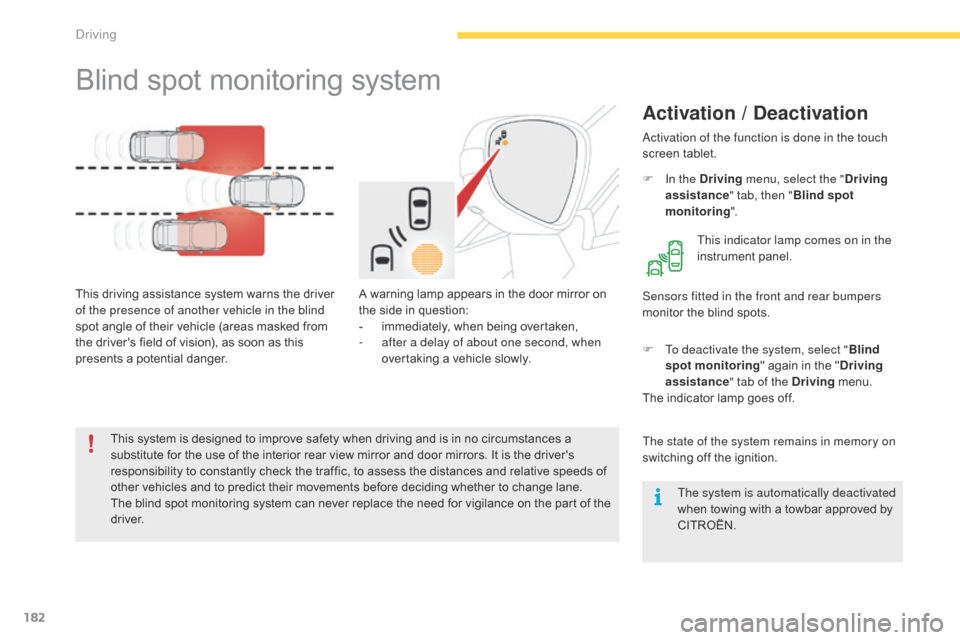
182
C4-Picasso-II_en_Chap04_conduite_ed01-2016
Blind spot monitoring system
Activation / Deactivation
A warning lamp appears in the door mirror on the  side  in  question:
-
Â
i
mmediately,  when  being  overtaken,
-
a
fter a delay of about one second, when
overtaking
 a  vehicle  slowly.
This
Â
driving
Â
assistance
Â
system
Â
warns
Â
the
Â
driver
 o
f the presence of another vehicle in the blind
spot
Â
angle
Â
of
Â
their
Â
vehicle
Â
(areas
Â
masked
Â
from
Â
t
he
Â
driver's
Â
field
Â
of
Â
vision),
Â
as
Â
soon
Â
as
Â
this
Â
p
resents
Â
a
Â
potential
Â
danger. Sensors fitted in the front and rear bumpers
monitor
 the  blind  spots.
This
Â
system
Â
is
Â
designed
Â
to
Â
improve
Â
safety
Â
when  driving  and  is  in  no  circumstances  a Â
s
ubstitute
Â
for
Â
the
Â
use
Â
of
Â
the
Â
interior
Â
rear
Â
view
Â
mirror  and  door  mirrors.  It  is  the  driver's Â
r
esponsibility
Â
to
Â
constantly
Â
check
Â
the
Â
traffic,
Â
to  assess  the  distances  and  relative  speeds  of Â
o
ther
Â
vehicles
Â
and
Â
to
Â
predict
Â
their
Â
movements  before  deciding  whether  to  change  lane.
The
Â
blind
Â
spot
Â
monitoring
Â
system
Â
can
Â
never
Â
replace  the  need  for  vigilance  on  the  part  of  the Â
d
river. Activation of the function is done in the touch
screen
 t
ablet.
F
I
n the Driving
menu, select the " Driving
assistance " tab, then "Blind spot
monitoring ".
This indicator lamp comes on in the
instrument
 pan
el.
The state of the system remains in memory on
switching  off  the  ignition.
F
T
o deactivate the system, select "Blind
spot monitoring "
 again  in  the  "Driving
assistance " tab of the Driving
Â
menu.
The
 indicator  lamp  goes  off.
The system is automatically deactivated
when
 towing  with  a  towbar  approved  by Â
CIT
ROĂ‹N.
Driving
Page 186 of 527
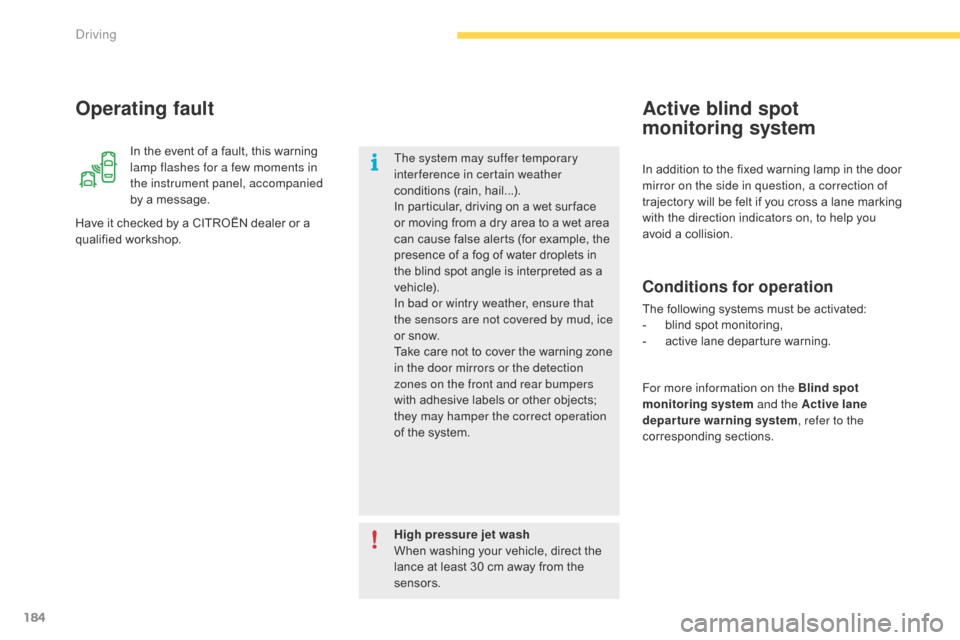
184
C4-Picasso-II_en_Chap04_conduite_ed01-2016
In the event of a fault, this warning lamp flashes for a few moments in
the instrument panel, accompanied
by
 a  message.
Operating fault
Have it checked by a CITROËN dealer or a qualified w orkshop. The system may suffer temporary
interference in certain weather
conditions
 (rain,  hail...).
In  particular,  driving  on  a  wet  sur face  o
r  moving  from  a  dry  area  to  a  wet  area  c
an  cause  false  alerts  (for  example,  the Â
p
resence  of  a  fog  of  water  droplets  in Â
t
he  blind  spot  angle  is  interpreted  as  a Â
v
ehicle).
In bad or wintry weather, ensure that
the sensors are not covered by mud, ice
or
 snow.
Take
 care  not  to  cover  the  warning  zone Â
i
n the door mirrors or the detection
zones on the front and rear bumpers
with
 adhesive  labels  or  other  objects; Â
t
hey may hamper the correct operation
of
 the  system.
High pressure jet wash
When
 washing  your  vehicle,  direct  the Â
l
ance  at  least  30  cm  away  from  the Â
sen
sors.In
 addition  to  the  fixed  warning  lamp  in  the  door Â
m
irror on the side in question, a correction of
trajectory  will  be  felt  if  you  cross  a  lane  marking  w
ith the direction indicators on, to help you
avoid  a  collision.
Conditions for operation
The following systems must be activated:
-  b lind  spot  monitoring,
-
Â
a
ctive  lane  departure  warning.
Active blind spot
monitoring system
For more information on the Blind spot
monitoring system and the Active lane
departure warning system , refer to the
corresponding
 s
ections.
Driving
Page 190 of 527
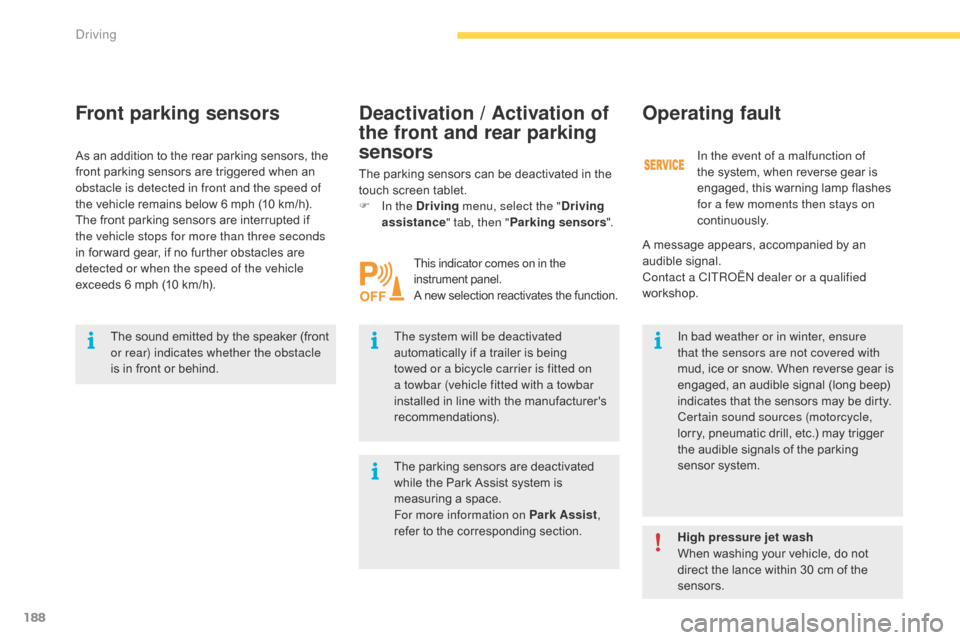
188
C4-Picasso-II_en_Chap04_conduite_ed01-2016
Front parking sensors
The sound emitted by the speaker (front or rear) indicates whether the obstacle
is
 in  front  or  behind. The system will be deactivated
automatically
 if  a  trailer  is  being Â
t
owed or a bicycle carrier is fitted on
a towbar (vehicle fitted with a towbar
installed
 in  line  with  the  manufacturer's Â
r
ecommendations).In bad weather or in winter, ensure
that the sensors are not covered with
mud,
 ice  or  snow.  When  reverse  gear  is Â
e
ngaged,  an  audible  signal  (long  beep) Â
i
ndicates  that  the  sensors  may  be  dirty.
Certain sound sources (motorcycle,
lorry,
 pneumatic  drill,  etc.)  may  trigger Â
t
he  audible  signals  of  the  parking Â
s
ensor  system.
As
Â
an
Â
addition  to  the  rear  parking  sensors,  the Â
f
ront
Â
parking  sensors  are  triggered  when  an Â
o
bstacle is detected in front and the speed of
the
Â
vehicle  remains  below  6  mph  (10  km/h).
The
Â
front  parking  sensors  are  interrupted  if Â
t
he vehicle stops for more than three seconds
in
Â
for ward  gear,  if  no  further  obstacles  are Â
d
etected or when the speed of the vehicle
exceeds  6  mph  (10  km/h). The  parking  sensors  can  be  deactivated  in  the Â
t
ouch  screen  tablet.
F
I
n the Driving
menu, select the " Driving
assistance " tab, then "Parking sensors ".
Operating fault
In the event of a malfunction of
the
 system,  when  reverse  gear  is Â
e
ngaged,  this  warning  lamp  flashes Â
f
or a few moments then stays on
continuously.
This indicator comes on in the
instrument pan el.
A
 new  selection  reactivates  the  function.
High pressure jet wash
When washing  your  vehicle,  do  not Â
d
irect  the  lance  within  30  cm  of  the Â
sen
sors.
The
Â
parking
Â
sensors
Â
are
Â
deactivated
Â
w
hile
Â
the
Â
Park
Â
Assist
Â
system
Â
is
Â
m
easuring
Â
a
Â
space.
For more information on Park Assist ,
refer
Â
to
Â
the
Â
corresponding
Â
section.
Deactivation / Activation of
the front and rear parking
sensors
A message appears, accompanied by an a
udible s ignal.
Contact a CITROĂ‹N dealer or a qualified
workshop.
Driving
Page 191 of 527

189
C4-Picasso-II_en_Chap04_conduite_ed01-2016
Reversing camera
Clean the reversing camera regularly u
sing  a  soft,  dry  cloth.
The
Â
reversing
Â
camera
Â
is
Â
activated
Â
automatically
 w
hen
 r
everse
 g
ear
 i
s
 enga
ged.
Depending
Â
on
Â
version,
Â
the
Â
image
Â
is
Â
displayed
Â
in
 t
he
Â
touch
Â
screen
Â
tablet
Â
or
Â
the
Â
instrument
Â
panel. The
Â
superimposed
Â
representation
Â
of
Â
guide
Â
l
ines
Â
helps
Â
with
Â
the
Â
manoeuvre. The
Â
blue  lines  represent  the  general  direction Â
o
f the vehicle (the difference corresponds to
the
Â
width  of  your  vehicle  without  the  mirrors).
The red lines represent a distance of about
30
Â
cm
 beyond  the  edge  of  your  vehicle's  rear Â
b
u m p e r.
The
Â
green  lines  represent  distances  of  about  1 Â
a
nd
Â
2
Â
metres  beyond  the  edge  of  your  vehicle's Â
r
ear
Â
bumper.
The turquoise blue curves represent the
maximum  turning  circle.
The
Â
reversing
Â
camera
Â
cannot
Â
in
Â
any
Â
c
ircumstances replace the need for
vigilance
Â
on
Â
the
Â
part
Â
of
Â
the
Â
driver. Opening
 the  tailgate  causes  the  display Â
t
o  disappear.
The
Â
reversing
Â
camera
Â
function
Â
may
Â
be
Â
c
ompleted
Â
with
Â
parking
Â
sensors.
High pressure jet washing
When
Â
washing
Â
your
Â
vehicle,
Â
do
Â
not
Â
d
irect
Â
the
Â
lance
Â
within
Â
30
Â
cm
Â
of
Â
the
Â
c
amera
Â
lens. They
Â
are
Â
represented
Â
by
Â
lines
Â
marked
 "
on
Â
the
Â
ground"
Â
and
Â
do
Â
not
Â
allow
Â
the p
osition of the vehicle to be determined
relative
Â
to
Â
tall
Â
obstacles
Â
(for
Â
example:
 o
ther
Â
vehicles,
Â
...).
Some
 d
eformation
 o
f
 t
he
 i
mage
 i
s
 n
ormal.
It is normal to be able to see part of
the number plate at the bottom of the
screen.
4
Driving
Page 192 of 527

190
C4-Picasso-II_en_Chap04_conduite_ed01-2016
360Â Vision
This system provides a view in the instrument
panel of  the  near  surroundings  of  your  vehicle, Â
u
sing  cameras  mounted  at  the  front  and  rear  of Â
y
our  vehicle  and  under  the  door  mirrors.
Depending
 on  the  angle  of  view  chosen  (front Â
v
iew,  rear  view  or  360°  panoramic  view), Â
3
60 Vision  provides  special  visual  assistance Â
i
n  particular  driving  conditions  such  as  when Â
e
ntering  a  blind  junction  or  manoeuvring  in Â
a
reas  of  reduced  visibility.
Once activated, this function operates up to
9Â mph
 (15  km/h).  Above  18  mph  (30  km/h),  the Â
f
unction  is  deactivated  automatically. This system is a visual aid which in no
circumstances can replace the need for
vigilance
 on  the  part  of  the  driver.
The  images  provided  by  the  cameras Â
m
ay  be  deformed  by  the  relief.  The Â
p
resence of areas in shade, in sunny
conditions,  or  of  low  ambient  light  may Â
d
arken  the  image  and  reduce  contrast.Forward vision
The camera located in the front bumper is
activated and views of the areas located at
front
 left  and  front  right  appear  simultaneously Â
i
n  the  instrument  panel.
Rear vision
The camera located in the tailgate is activated and the view of the area behind your vehicle is
displayed in the instrument panel and behaves
like
 a  reversing  camera,  whatever  the  position Â
o
f  the  gear  selector  lever.
The blue lines represent the width of your
vehicle
 (excluding  mirrors):  they  move Â
a
ccording  to  the  position  of  the  steering  wheel.
The
 red  line  represents  a  distance  of  30  cm Â
f
rom  the  rear  bumper,  and  the  two  green Â
l
ines, 1 m and 2 m from the rear bumper,
respectively.
Rear vision is displayed automatically
when
 engaging  reverse,  regardless  of Â
t
he  state  of  the  system.
Driving
Page 200 of 527

198
C4-Picasso-II_en_Chap04_conduite_ed01-2016
F Select reverse,  release  the  steering  wheel  a
nd  start  moving  without  exceeding  4  mph Â
(
7 Â km/h).
F
Â
T
he  assisted  parking  manoeuvre  is  in Â
p
rogress.
 W
ithout  exceeding  4  mph  (7  km/h),  follow Â
t
he instructions displayed in the instrument
panel,
 aided  by  the  warnings  from  the Â
"
Parking  sensors"  system,  until  the Â
i
ndication  of  the  end  of  the  manoeuvre.At
 the  end  of  the  manoeuvre,  the  operating  i
ndicator  lamp  goes  off  in  the  instrument  panel, Â
a
ccompanied  by  a  message  and  an  audible Â
s
ignal.
The
 assistance  is  deactivated:  you  can  take Â
ov
er  control.During
 parking  and  exit  from  p
arking  manoeuvres,  the  reversing Â
c
amera function may come into
operation.
 It  facilitates  monitoring  of Â
t
he  surroundings  of  the  vehicle,  by Â
d
isplaying  additional  information  in  the Â
in
strument
 pan
el.
For more information on the Reversing
camera ,
 refer  to  the  corresponding Â
s
ection.
During
 a  bay  parking  manoeuvre,  the Â
P
ark  Assist  system  is  automatically Â
d
eactivated once the rear of the vehicle
is  within  50  cm  of  an  obstacle.
Driving